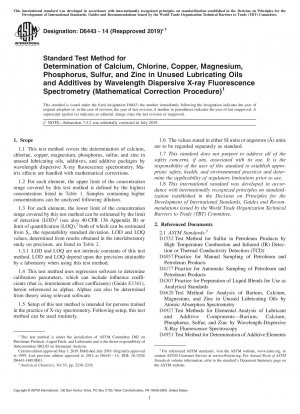ASTM D6443-14(2019)e1
Standard Test Method for Determination of Calcium, Chlorine, Copper, Magnesium, Phosphorus, Sulfur, and Zinc in Unused Lubricating Oils and Additives by Wavelength Dispersive X-ray Fluorescence Spectr
- Standard No.
- ASTM D6443-14(2019)e1
- Release Date
- 2019
- Published By
- American Society for Testing and Materials (ASTM)
- Latest
- ASTM D6443-14(2019)e1
- Scope
- 1.1 This test method covers the determination of calcium, chlorine, copper, magnesium, phosphorus, sulfur, and zinc in unused lubricating oils, additives, and additive packages by wavelength dispersive X-ray fluorescence spectrometry. Matrix effects are handled with mathematical corrections. 1.2 For each element, the upper limit of the concentration range covered by this test method is defined by the highest concentration listed in Table 1. Samples containing higher concentrations can be analyzed following dilution. 1.3 For each element, the lower limit of the concentration range covered by this test method can be estimated by the limit of detection (LOD)2 (see also 40 CFR 136 Appendix B) or limit of quantification (LOQ),2 both of which can be estimated from Sr, the repeatability standard deviation. LOD and LOQ values, determined from results obtained in the interlaboratory study on precision, are listed in Table 2. 1.3.1 LOD and LOQ are not intrinsic constants of this test method. LOD and LOQ depend upon the precision attainable by a laboratory when using this test method. 1.4 This test method uses regression software to determine calibration parameters, which can include influence coefficients (that is, interelement effect coefficients) (Guide E1361), herein referenced as alphas. Alphas can also be determined from theory using relevant software. 1.5 Setup of this test method is intended for persons trained in the practice of X-ray spectrometry. Following setup, this test method can be used routinely. 1.6 The values stated in either SI units or angstrom (Å) units are to be regarded separately as standard. 1.7 This standard does not purport to address all of the safety concerns, if any, associated with its use. It is the responsibility of the user of this standard to establish appropriate safety, health, and environmental practices and determine the applicability of regulatory limitations prior to use. 1.8 This international standard was developed in accordance with internationally recognized principles on standardization established in the Decision on Principles for the Development of International Standards, Guides and Recommendations issued by the World Trade Organization Technical Barriers to Trade (TBT) Committee.
ASTM D6443-14(2019)e1 Referenced Document
- ASTM D1552 Standard Test Method for Sulfur in Petroleum Products (High-Temperature Method)
- ASTM D4057 Standard Practice for Manual Sampling of Petroleum and Petroleum Products
- ASTM D4177 Standard Practice for Automatic Sampling of Petroleum and Petroleum Products
- ASTM D4307 Standard Practice for Preparation of Liquid Blends for Use as Analytical Standards
- ASTM D4628 Standard Test Method for Analysis of Barium, Calcium, Magnesium, and Zinc In Unused Lubricating Oils By Atomic Absorption Spectrometry
- ASTM D4927 Standard Test Methods for Elemental Analysis of Lubricant and Additive Components8212;Barium, Calcium, Phosphorus, Sulfur, and Zinc by Wavelength-Dispersive X-Ray Fluorescence Spectroscopy
- ASTM D4951 Standard Test Method for Determination of Additive Elements in Lubricating Oils by Inductively Coupled Plasma Atomic Emission Spectrometry*, 2019-12-01 Update
- ASTM D5185 Standard Test Method for Determination of Additive Elements, Wear Metals, and Contaminants in Used Lubricating Oils and Determination of Selected Elements in Base Oils by Inductively Coupled Plasma Atomic Emission Spectrometry (ICP-AES)
- ASTM D6299 Standard Practice for Applying Statistical Quality Assurance and Control Charting Techniques to Evaluate Analytical Measurement System Performance*, 2023-07-01 Update
- ASTM E1361 Standard Guide for Correction of Interelement Effects in X-Ray Spectrometric Analysis
- ASTM E29 Standard Practice for Using Significant Digits in Test Data to Determine Conformance with Specifications
ASTM D6443-14(2019)e1 history
- 2019 ASTM D6443-14(2019)e1 Standard Test Method for Determination of Calcium, Chlorine, Copper, Magnesium, Phosphorus, Sulfur, and Zinc in Unused Lubricating Oils and Additives by Wavelength Dispersive X-ray Fluorescence Spectr
- 2014 ASTM D6443-14 Standard Test Method for Determination of Calcium, Chlorine, Copper, Magnesium, Phosphorus, Sulfur, and Zinc in Unused Lubricating Oils and Additives by Wavelength Dispersive X-ray Fluorescence Spectrometry (Mathematical Correction Procedure)
- 2004 ASTM D6443-04(2010) Test Method for Determination of Calcium, Chlorine, Copper, Magnesium, Phosphorus, Sulfur, and Zinc in Unused Lubricating Oils and Additives by Wavelength Dispersive X-ray Fluorescence Spectrometry (Mathematical Correction Procedure)
- 2004 ASTM D6443-04 Test Method for Determination of Calcium, Chlorine, Copper, Magnesium, Phosphorus, Sulfur, and Zinc in Unused Lubricating Oils and Additives by Wavelength Dispersive X-ray Fluorescence Spectrometry (Mathematical Correction Procedure)
- 1999 ASTM D6443-99 Test Method for Determination of Calcium, Chlorine, Copper, Magnesium, Phosphorus, Sulfur, and Zinc in Unused Lubricating Oils and Additives by Wavelength Dispersive X-ray Fluorescence Spectrometry (Mathematical Correction Procedure)
